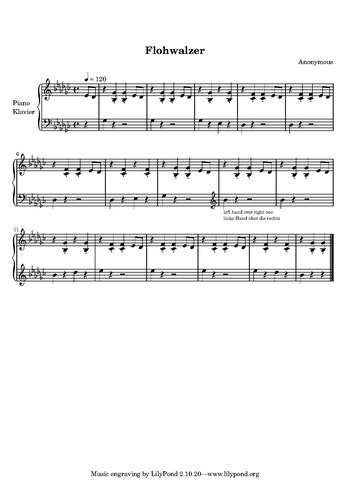Flohwalzer
Flohwalzer (German: ['floːvaltsər] (![]()
Music
Despite its name, the piece is not a waltz in triple meter, as it has a time signature in duple meter. The composer is unknown. A parody of musicology writing by Eric Baumann attributes the piece to Ferdinand Loh, but this is obviously a joke ("F. Loh" = Floh, flea in German).[1] The piece is notated in the key of G-flat major, because most of its notes are played on black keys in those keys, makes the fingering easier.
International
It is known all over the world. According to an article by Hiromi Oketani in the Osaka Shoin Women's College Annual for 1994,[2] it is known in Japan as "Neko Funjatta" (ねこふんじゃった, I Stepped on the Cat), in Spain as "La Chocolatera", in the Netherlands as "Vlooienmars" (Flea March), in Belgium as "Valse de Puce" (Flea Waltz), in Russia as Russian: Собачий Вальс, romanized: Sobachiy Val's, lit. 'Dog Waltz', in Poland as "Kotlety" (Cutlet), in Bulgaria as "Koteshki Marsh" (Cat March), in Hungary as "Szamárinduló" (Donkey March), and in Majorca as "Polca de los Tontos" (Fools' Polka). In Mexico, it is called "Los Changuitos" (The Little Monkeys), in Finland "Kissanpolkka" (Cat's Polka), in the Czech Republic "Prasečí valčík" (Pig Waltz), in Slovakia "Somársky pochod" (Donkey March), and in Korean "고양이 춤" (Cat Dance). In China, it is called "跳蚤圆舞曲" (Flea Waltz). In the United Kingdom, the melody is known as "Chopsticks", but in the US that name refers to another melody, "Chopsticks". In Taiwan, it is known as "踩到貓兒" (Stepped on a Cat).
Arrangements
An elaborate variation on this piece, "Lesson One", was a hit in 1962 for pianist Russ Conway.[3] Danish pianist Bent Fabric released a jazz-influenced version in 1963 as "Chicken Feed".[4]
Swedish songwriter Thore Skogman used the piece as the basis for his 1962 song "Kalle Johansson" (which has since become the Swedish name for the melody in general), featuring lyrics about a man named Kalle Johansson, who gets in a love affair that involves him, his sister, and two of their neighbors.
Notes
- Baumann, Eric (1996). Der Komponist Ferdinand Loh und sein opus magnum: Der Flohwalzer. Zürich: Atlantis Musikbuch-Verlag. ISBN 3-254-00205-9. 62 pages.
- Hitomi Oketani. " 'Neko Funjatta', the Well-Known Piano Piece: The Circumstances of Its Composition", Shoin Women's College Annual 31 (1994), pp. 161–170.
- Russ Conway and orchestra on YouTube
- "Chicken Feed" on YouTube
External links
- Tutorial on YouTube
- Animated score on YouTube
- 12 variations on YouTube, Jean Panajotoff
